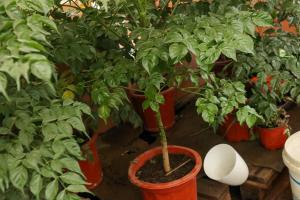Introduction
Tomato plants are among the most popular vegetables grown in home gardens. They are easy to grow and produce a bountiful crop of juicy and flavorful fruit. One of the common problems that tomato gardeners face are brown spots on the leaves of the plant. In this article, we will discuss what brown spots on tomato plant leaves mean and how to prevent them from occurring.
Possible Causes of Brown Spots on Tomato Plant Leaves
There are several possible causes of brown spots on tomato plant leaves. One of the most common causes is a fungal disease called early blight. This disease is caused by the fungus Alternaria solani and can cause brown or black spots on the lower leaves of the plant. Eventually, the entire leaf can turn yellow and fall off the plant.
Another possible cause of brown spots on tomato plant leaves is a condition called blossom end rot. This condition is caused by a lack of calcium in the soil, which causes the bottom of the tomato fruit to turn brown and mushy. The brown spots on the leaves in this case are a symptom of the larger problem.
Insects can also cause brown spots on tomato plant leaves. One example is the tomato hornworm, a large green caterpillar that feeds on the leaves of tomato plants. The caterpillar can cause extensive damage to the plant, including brown spots on the leaves.
Treatment and Prevention
If you notice brown spots on the leaves of your tomato plant, it is important to take action quickly to prevent the spread of disease or damage. Here are some steps you can take to treat and prevent brown spots on tomato plant leaves:
1. Remove affected leaves: If the brown spots are caused by a fungal disease or insect infestation, it is important to remove infected leaves from the plant to prevent the spread of the disease or damage. Use clean, sharp scissors to cut off the affected leaves at the base of the stem.
2. Provide adequate water and nutrients: Proper watering and fertilization can help prevent brown spots on tomato plant leaves. Make sure the plant is receiving adequate water and nutrients, including calcium, which is important for preventing blossom end rot.
3. Use organic methods to control insects: Instead of using chemical pesticides to control insects, try using natural methods such as companion planting or introducing beneficial insects like ladybugs or lacewings to your garden.
4. Rotate crops: If you have a problem with fungal diseases on your tomato plants, it may be helpful to rotate crops in your garden. This means planting tomatoes in a different location or soil type each year to prevent the buildup of disease in the soil.
5. Prune and stake plants: Pruning and staking your tomato plants can also help prevent the spread of disease by improving air circulation and reducing the contact between the leaves and soil.
Conclusion
Brown spots on tomato plant leaves can be caused by a variety of factors, including fungal diseases, lack of calcium in the soil, and insect infestations. Taking steps to prevent and treat these problems can help ensure a healthy and productive tomato crop. Make sure to provide your tomato plants with adequate water and nutrients, use organic methods to control insects, and practice good crop rotation and pruning techniques to prevent the spread of disease.

 how many times do yo...
how many times do yo... how many planted tre...
how many planted tre... how many pine trees ...
how many pine trees ... how many pecan trees...
how many pecan trees... how many plants comp...
how many plants comp... how many plants can ...
how many plants can ... how many plants and ...
how many plants and ... how many pepper plan...
how many pepper plan...






























